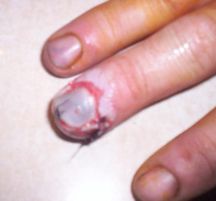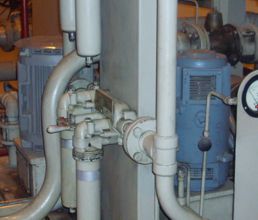Prevent Crushed Fingers
 Each year, workers suffer approximately 125,000 injuries that occur when body parts get caught between two objects or entangled with machinery. These hazards are referred to as “pinch points”. If you have ever slammed your finger in a door, you can appreciate the pain associated with this common type of caught/crush injury. The physical forces applied to a body part caught in a pinch point can vary and cause injuries ranging from bruises and cuts to amputated body parts and even death.
Each year, workers suffer approximately 125,000 injuries that occur when body parts get caught between two objects or entangled with machinery. These hazards are referred to as “pinch points”. If you have ever slammed your finger in a door, you can appreciate the pain associated with this common type of caught/crush injury. The physical forces applied to a body part caught in a pinch point can vary and cause injuries ranging from bruises and cuts to amputated body parts and even death.
To prevent these injuries, look for possible pinch points before you start a task. Take the time to plan out your actions and decide on the necessary steps to work safely. Give your work your full attention. Don’t joke around, daydream, or try to multi-task on the job – most accidents occur when workers are distracted. Read and follow warning signs posted on equipment. If you value all that your hands can do, THINK before you put them in a hazardous spot.
Also, dress appropriately for work with pants and sleeves that are not too long or too loose. Shirts should be fitted or tucked in. Do not wear any kind of jewelry. Tie back long hair and tuck braids and ponytails behind you or into your clothing. Wear the appropriate, well-fitting gloves for your job.
Machinery can pose a hazard with moving parts, conveyors, rollers, and rotating shafts; these are only a few of the vast number of hazards. Never reach into a moving machine. Properly maintain and always use the machine and tool guards provided with your equipment. Don’t reach around, under, or through a guard and always report missing or broken barriers to your supervisor. These guards act as a barrier between the moving parts and your body. Turn equipment off and use lockout/tagout procedures before adjusting, clearing a jam, repairing, or servicing a machine.
Vehicles, powered doors, and forklifts can pose a crush hazard unless they have been blocked or tagged out. Never place your body under or between powered equipment unless it is de-energized. Doors, file drawers, and heavy crates can pinch fingers and toes. Take care where you place your fingers. Test the weight before lifting, carrying, and placing boxes; an awkward or heavy load can slip and pinch your hands or feet. Get help or use tools to move large and/or heavy items.
Take the time to learn about the caught/crush hazards in your workplace so you don’t learn about the consequences first hand (no pun intended).

 The International Association of Engineering Insurers found that the highest frequency of steam turbine failures worldwide is due to loss of oil pressure. Most of these failures are caused by an unreliable backup system to maintain oil pressure to the bearings should the primary AC-driven lube oil pumps fail. These AC motors are powered by either the turbine’s output or the grid, and will fail if the turbine or generator trips, or if there is an external outage.
The International Association of Engineering Insurers found that the highest frequency of steam turbine failures worldwide is due to loss of oil pressure. Most of these failures are caused by an unreliable backup system to maintain oil pressure to the bearings should the primary AC-driven lube oil pumps fail. These AC motors are powered by either the turbine’s output or the grid, and will fail if the turbine or generator trips, or if there is an external outage.